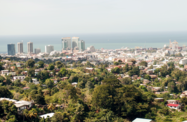As the outlook for the energy sector improves, there are signs that broader economic activity could pick up this year as well.

In its monetary policy announcement issued January 27, the Central Bank of T&T said the domestic economic environment continued to be characterised by sluggishness, with retail, construction and its associated industries remaining subdued.
Yet the report also contained some positive indications, not least forecasts that the energy sector – the biggest contributor to T&T’s economy, at around 40% of GDP – was expected to perform better in 2017. Expected increases in production and prices, it said, could see more capital flowing into the domestic economy.
Recovery forecast
Suggestions of a coming economic turnaround were supported by projections by the IMF, which expects T&T’s economy to move out of recession and expand by 2.28% this year and 2.6% in 2018.
Another bright spot was a decision by the bank’s monetary policy committee to maintain its repo rate at 4.75%, citing international financial dynamics and the domestic economy’s performance. The central bank last raised interest rates in December 2015, when it lifted the repo rate by 25 basis points.
Maintaining rates at their present level could encourage more private sector borrowing, though the latest data shows that credit growth remains muted.
Lending flows to the private sector have see-sawed in recent months, dipping in August, then rising in September by 3.5% year-on-year (y-o-y), only to fall 3% y-o-y in October and rebound again in November by 3.8% y-o-y, according to central bank data issued in late January.
The November jump can be partially attributed to seasonal factors: the end-of-year holiday period, which traditionally sees higher spending, could potentially be driving borrowing, though this impact appears to have been more muted than in previous years.
In its January report the bank characterised credit growth as “moderate”, an improvement on the “sluggish” description it gave in its November monetary policy announcement.
Budget boost
In a bid to curb outflows of foreign exchange, in the last budget, handed down at the end of September, the government imposed a 7% levy on online purchases from overseas delivered by air. The tax, which came into force on October 20, is expected to bring in as much as $70m ($10.4m) annually to public coffers and the boost competitiveness of local retailers.
Unpopular as the levy is with air freight and logistics companies, for which it should erode business, Colm Imbert, the minister of finance, has said the tax should help local manufacturers and service companies compete.
The tax’s aim is to level the playing field between cheaper imports and goods produced or sold locally, which are subject to domestic levies or import duties.
Supply opportunities
Another commentator foreseeing growth opportunities in T&T – particularly in relation to imports – is the US Department of Agriculture’s Foreign Agricultural Service (FAS).
In a report issued at the end of last year, the FAS said that while low energy prices had recently stifled growth, T&T remained one of the largest and most dynamic markets in the Caribbean, and had a diverse retail market.
Despite government efforts to stimulate primary-sector production, T&T remains reliant on imports to maintain its food supply – prompting the FAS report to highlight opportunities for food and beverage importers.
While the US is the largest source of consumer-oriented imports in T&T, accounting for around 44% of the market, followed by New Zealand at 7%, its dominance of the market is projected to shift somewhat.
EU exporters are beginning to take advantage of lower tariff barriers and penetrate T&T’s market, the FAS report said, showing the country’s increasing appeal to European companies looking gain a foothold in its retail supply chain.


